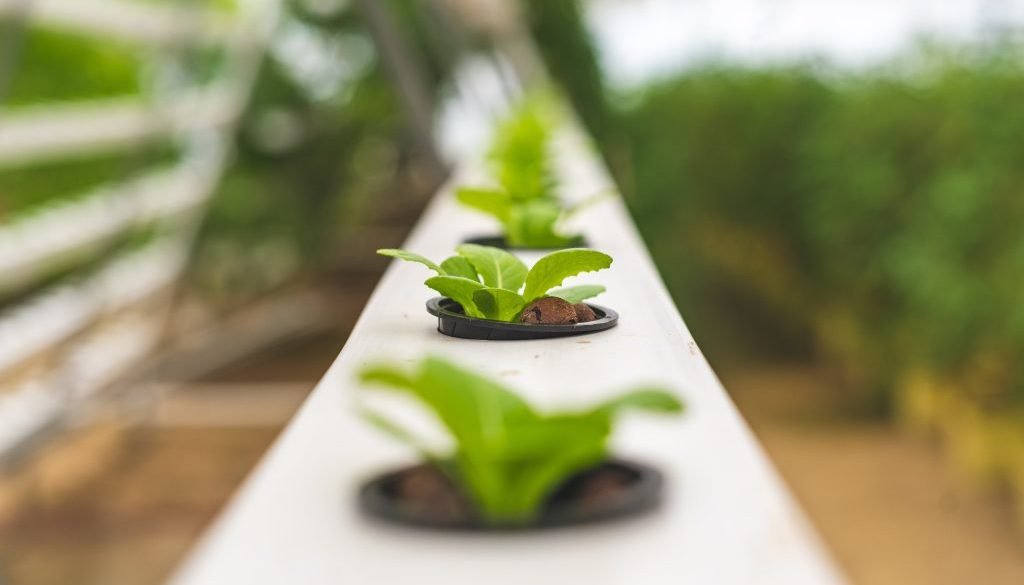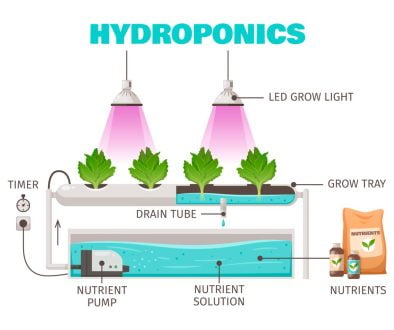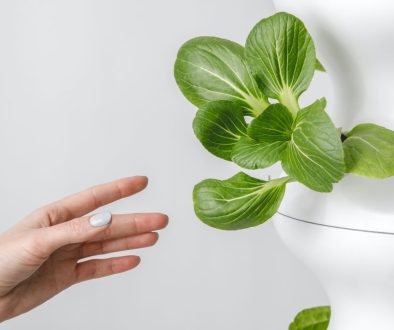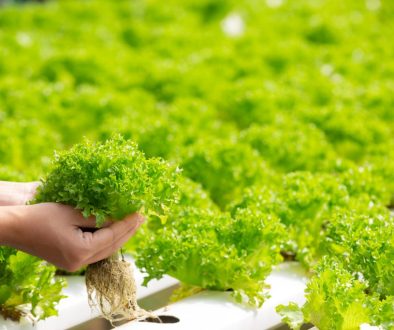In the realm of modern gardening and agricultural innovation, the term “hydroponics” has been gaining considerable attention. For the uninitiated, the concept might seem complex and overwhelming. In this guide, we’ll delve into the essence of hydroponics, unravel its historical background, and illuminate its functionality for those just beginning their exploration of this fascinating soilless gardening method.
Key Points (TLDR)
In the realm of modern gardening and agricultural innovation, the term “hydroponics” has been gaining considerable attention. For the uninitiated, the concept might seem complex and overwhelming. In this guide, we’ll delve into the essence of hydroponics, unravel its historical background, and illuminate its functionality for those just beginning their exploration of this fascinating soilless gardening method.
Discovering the evolution and functionality of hydroponic systems for novice enthusiasts
Definition of hydroponics
Hydroponics is a method of growing plants without soil, using a nutrient-rich solution to provide essential elements required for plant growth. This technique offers an alternative to traditional soil-based cultivation, relying on water and mineral solutions to sustain plant growth.
Brief Overview of the Topic
The concept of hydroponics revolutionizes the way we perceive plant cultivation. Its reliance on water-based systems instead of soil opens the door to new possibilities, particularly in environments where traditional agriculture faces limitations.
Historical Background
Origins of Hydroponics
The origins of hydroponics trace back to ancient civilizations, where the Hanging Gardens of Babylon and the Aztecs’ floating gardens showcased early forms of soilless plant cultivation. However, the formalized concept emerged in the 19th century.
Milestones in Its Development
Throughout history, significant milestones have shaped the evolution of hydroponics. From the experiments of scientists like Julius von Sachs to the advancements in the 20th and 21st centuries, hydroponics has continually progressed, incorporating technological innovations and scientific understanding.
As we explore this subject further, we will uncover the various forms of hydroponic systems, their functions, and the modern applications that make hydroponics a game-changer in agricultural practices.
Stay tuned for the next segment, where we will delve into the different types of hydroponic systems, their operational methods, and the benefits they offer for aspiring hydroponic enthusiasts.
For those new to this innovative gardening technique, understanding its historical journey and fundamental operations is the first step toward mastering hydroponics. Join us on this educational journey to unearth the secrets and potential of soilless gardening.
Understanding the Principles and Types of Hydroponic Systems for Beginners
Are you intrigued by the concept of hydroponics but feeling overwhelmed by the vast amount of information out there? Whether you’re a curious novice or someone looking to explore the world of soilless gardening, this comprehensive guide will take you on a journey to demystify hydroponics. In this article, we’ll explore the principles behind hydroponics and dive into the various types of hydroponic systems that are transforming the way we grow plants.
Principles of hydroponics
The Role of Water and Nutrients
Hydroponics, at its core, is a method of cultivating plants without soil. Instead, it relies on a nutrient-rich water solution to deliver essential elements directly to the plant’s roots. This precise control over nutrient intake promotes faster and healthier growth.
Elimination of Soil
The elimination of soil is one of the defining features of hydroponics. By removing soil from the equation, gardeners can overcome issues such as poor soil quality, pests, and diseases. This soilless approach is especially beneficial for urban and indoor gardening, where traditional soil-based methods may not be feasible.
Control of Environmental Factors
Hydroponics allows for meticulous control over environmental factors such as light, temperature, and humidity. This control optimizes growing conditions, resulting in accelerated growth and higher crop yields. As a hydroponic gardener, you become the ultimate architect of your plant’s environment.
Types of hydroponic systems
Hydroponics offers a range of systems, each with its own unique characteristics. Here are some of the most popular hydroponic systems:
Nutrient Film Technique (NFT)
NFT systems involve a thin film of nutrient-rich water flowing over the plant roots. This method provides a constant supply of nutrients while also allowing for efficient oxygenation of the roots. NFT systems are known for their simplicity and suitability for growing smaller plants.
Deep Water Culture (DWC)
DWC systems immerse plant roots directly in a nutrient-rich solution. Oxygen is supplied through air stones, creating an ideal environment for root development. These systems are popular for growing larger plants, such as tomatoes and cucumbers.
Drip Systems
Drip systems deliver nutrient solutions to plant roots through a network of tubes and drip emitters. They are highly adaptable and can be used for a wide range of plant sizes and types. Drip systems are known for their efficiency and water conservation.
Wick Systems
Wick systems are the most straightforward of all hydroponic systems. They rely on a wick, usually made of cotton, or felt, to transport nutrients from a reservoir to the plant roots. Wick systems are easy to set up and are perfect for beginners.
Aeroponics
Aeroponics takes a unique approach by suspending plant roots in a mist or aerosol of nutrient solution. This method maximizes oxygen exposure, promoting rapid growth. Aeroponics systems are favoured for their efficiency and suitability for a wide range of plant types.
As a beginner in the world of hydroponics, understanding these principles and types of hydroponic systems is the first step in embarking on your soilless gardening journey. In the subsequent parts of this series, we will delve deeper into each of these systems, providing you with the knowledge and confidence to start your own hydroponic garden. Whether you’re growing herbs on your windowsill or vegetables in a greenhouse, hydroponics opens up a world of possibilities for plant enthusiasts of all levels. Stay tuned for more insights and practical tips in our upcoming articles.
Exploring efficiency, yield, and year-round cultivation in soilless gardening
If you’ve ever dreamed of growing your own garden without the need for traditional soil, hydroponics might be the answer you’ve been looking for. In this comprehensive guide, we’ll uncover the secrets of hydroponics, from its remarkable benefits to the unique challenges and considerations it entails. Whether you’re an amateur or a green-thumbed enthusiast, this article will help you understand the wonders of hydroponic gardening.
What is Hydroponics, and How Does It Work?
Before delving into the benefits and challenges of hydroponics, let’s grasp the core principles of this innovative gardening method.
Hydroponics is a soilless cultivation technique that relies on a nutrient-rich water solution to deliver essential elements directly to plant roots. This precise control over nutrient intake not only promotes faster and healthier growth but also eliminates the need for traditional soil. Hydroponic systems also provide meticulous control over environmental factors, such as light, temperature, and humidity, optimizing growing conditions for plants.
Now, let’s explore the advantages of hydroponics that make it an increasingly popular choice for gardeners of all levels.
Benefits of hydroponics
Increased Growth and Yield
Hydroponic systems provide plants with a constant and readily available supply of nutrients, ensuring they receive precisely what they need. As a result, plants tend to grow faster and produce higher yields compared to traditional soil-based gardening.
Water and Resource Efficiency
One of the most significant advantages of hydroponics is its water efficiency. These systems recycle and reuse water, reducing water wastage significantly. Hydroponics also uses fewer resources like fertilizers and pesticides, making it an environmentally friendly option.
Pest and Disease Control
With no soil to harbour pests and diseases, hydroponic gardens are less prone to infestations. This reduces the need for chemical pesticides, promoting healthier and safer produce.
Year-Round Cultivation
Hydroponic systems can be set up indoors, allowing you to grow plants year-round. Regardless of the weather outside, you can maintain a thriving garden, providing you with a continuous supply of fresh produce.
Now, while hydroponics offers numerous advantages, it’s essential to consider the challenges and considerations involved in adopting this innovative gardening method.
Challenges and considerations
Initial Setup Costs
Setting up a hydroponic system can require an initial investment. You’ll need equipment, such as grow lights, pumps, and nutrient solutions, which can add up. However, the long-term benefits and reduced resource usage often outweigh the upfront costs.
Maintenance and Monitoring
Hydroponic systems demand regular monitoring to ensure proper nutrient levels, pH balance, and overall system health. This means dedicating time and effort to maintain your garden, especially during the initial learning phase.
Sustainability Concerns
While hydroponics can be resource-efficient, it’s essential to choose sustainable practices. This includes responsibly disposing of water and nutrient solutions and considering the environmental impact of the materials and equipment used.
In conclusion, hydroponics is a revolutionary approach to gardening, offering a multitude of benefits such as increased growth, resource efficiency, and pest control. However, it comes with its unique set of challenges and considerations. As you embark on your hydroponic journey, understanding these factors will help you make informed decisions and create a thriving, soilless garden. Whether you’re growing herbs on your windowsill or cultivating a bountiful indoor farm, hydroponics opens up a world of possibilities for plant enthusiasts of all levels.
Exploring hydroponic plant examples and DIY hydroponic systems for novices
Have you ever wondered what hydroponics is and how it can transform the way you grow plants? Whether you’re a novice in the world of soilless gardening or simply curious, this comprehensive guide will demystify hydroponics. In this article, we’ll not only dive into the core principles of hydroponics but also explore various hydroponic plant examples and provide a beginner’s guide to setting up your own DIY hydroponic system.
What is hydroponics, and how does it work?
Hydroponics is an innovative method of cultivating plants without traditional soil. Instead, it relies on a nutrient-rich water solution to deliver essential elements directly to plant roots. This precise control over the plant’s environment accelerates growth and increases yields. Now, let’s explore some examples of the plants that thrive in hydroponic systems.
Examples of Hydroponic Plants
Common Crops Grown Hydroponically
- Lettuce: Leafy greens, particularly lettuce, are popular choices for hydroponic cultivation due to their rapid growth and high demand.
- Tomatoes: Hydroponic tomatoes are known for their consistent quality and flavor. They flourish in controlled environments.
- Cucumbers: Cucumbers thrive in hydroponic systems, producing plentiful yields and uniform fruits.
- Herbs: Basil, mint, and other herbs are well-suited for hydroponics, offering a year-round supply of fresh culinary delights.
Unique and Experimental Crops
- Strawberries: Hydroponic strawberries are a delightful and unconventional choice, yielding sweet, juicy berries in a controlled environment.
- Orchids: Orchids, known for their elegance, can be successfully grown hydroponically with precise nutrient management.
- Exotic Greens: Experiment with unique and exotic greens, such as kale and arugula, to add variety to your hydroponic garden.
Now, let’s transition to the exciting world of DIY hydroponics for beginners.
DIY hydroponics: how to get started
If you’re eager to start your own hydroponic garden, you’re in the right place. Here’s a step-by-step guide to setting up a small-scale DIY hydroponic system:
Step 1: Choose Your System
Select a hydroponic system that suits your space and resources. Some beginner-friendly options include the Kratky method, Deep Water Culture (DWC), or a simple nutrient film technique (NFT) system.
Step 2: Gather Materials
You’ll need a few essential items: a container for your plants, growing medium (like perlite or coconut coir), nutrient solution, pH testing kit, and an air pump for oxygenation in some systems.
Step 3: Plant Your Crops
Carefully plant your chosen hydroponic crops in the growing medium and position them in the container. Ensure proper spacing and support for taller plants.
Step 4: Nutrient Management
Mix the nutrient solution according to the instructions and maintain the pH level within the recommended range. Regularly check and adjust nutrient levels as needed.
Step 5: Monitor and Maintain
Keep a close eye on your hydroponic system, ensuring adequate lighting, temperature, and humidity. Prune, harvest, and maintain your plants as they grow.
Step 6: Enjoy the Harvest
In no time, you’ll be enjoying the fruits (or greens) of your labor. Hydroponic gardening can be a rewarding and sustainable way to grow your own fresh produce.
Hydroponics offers a world of possibilities for plant enthusiasts, from growing everyday crops to experimenting with exotic varieties. Whether you’re interested in sustainable gardening or just want to explore a new way of cultivating plants, hydroponics is a journey well worth embarking on. Stay tuned for more in-depth articles that will guide you through the finer details of hydroponic systems and advanced techniques.
Exploring commercial applications, future trends, and the promise of soilless cultivation
Hydroponics, a remarkable soilless gardening method, is transforming the way we grow crops and reshape the future of agriculture. In this extensive guide, we’ll delve into the essence of hydroponics, its commercial applications, futuristic innovations, and its potential to revolutionize modern farming practices. Let’s embark on an enlightening journey.
What is Hydroponics, and How Does It Work?
Before we venture into the commercial realm and futuristic trends, let’s grasp the fundamentals.
Hydroponics is a revolutionary technique that enables plant growth without soil. Instead, it employs a nutrient-rich water solution to nourish plants directly at their roots. The elimination of soil paves the way for precise control over growing conditions, ultimately leading to rapid growth and increased crop yields.
Commercial applications
Hydroponics in Agriculture
Commercial agriculture is at the forefront of hydroponic adoption. From leafy greens to vine-ripe tomatoes, large-scale hydroponic systems have redefined how we approach food production. Notably, hydroponics conserves water and land, reduces pest and disease pressure, and maximizes crop yield. The controlled environment ensures consistent quality and availability.
Hydroponics in Urban Farming
Urban spaces are embracing hydroponics as a solution to fresh and sustainable produce. Vertical farms and rooftop gardens are popping up in city landscapes, offering locally grown, organic crops year-round. Hydroponics in urban farming contributes to food security, reduces transportation costs, and lessens the urban heat island effect.
Future trends and innovations
- Advancements in Technology
The future of hydroponics is intertwined with technological progress. Automation, data analytics, and AI-controlled systems are poised to enhance precision and efficiency. Remote monitoring and sensor-driven adjustments will become standard practices, reducing labor and resource costs.
- Integration with Other Agricultural Practices
Hydroponics is not isolated; it harmonizes with other farming methods. Integrated farming systems that combine hydroponics with aquaculture or aquaponics are gaining momentum. These symbiotic relationships lead to nutrient cycling and reduced environmental impact.
Summary of key points
Hydroponics is a revolutionary soilless cultivation technique with vast potential. It offers resource efficiency, year-round production, and solutions to urban and commercial farming challenges.
The Potential of Hydroponics in Modern Agriculture
The potential of hydroponics in modern agriculture is boundless. As we harness technological advancements and integrate hydroponics with other practices, we pave the way for a sustainable and thriving future in food production.
Additional resources
Books, Websites, and Organizations
To delve deeper into hydroponics, check out the following resources:
- Books: “Hydroponics for Beginners” by Laura Sullivan, “The Hydroponic Bible” by Lewis Stoneton
- Websites: Hydroponics Association (www.hydroassoc.com), Hydroponics Online (www.hydroponicsonline.com)
- Organizations: The Hydroponic Society of America, The Hydroponic Farmers Alliance
As you embark on your hydroponic journey, remember that the future of agriculture is evolving with this innovative technique. Stay informed, get your hands dirty (or not, in the case of soilless gardening), and embrace the potential of hydroponics in shaping the way we feed the world.




